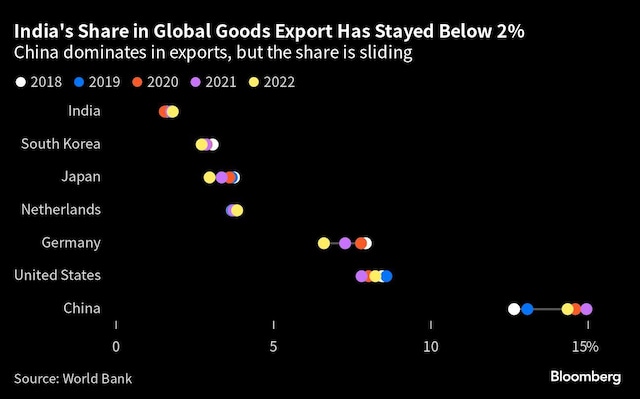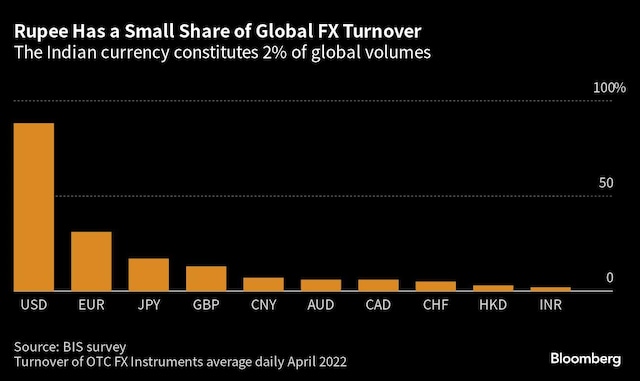India’s campaign to internationalise rupee gets off to a slow start
India’s year-old campaign to boost the rupee’s role in cross-border payments has made little headway, according to people familiar with the matter, underscoring the challenges for countries trying to reduce their dependence on the dollar.
The Reserve Bank of India has allowed more than a dozen banks to settle trades in rupees with 18 countries since last year and is encouraging big oil exporters such as the UAE and Saudi Arabia to South Asian nations to accept the Indian currency for trade settlements.
But success has been elusive so far with total local currency trade volumes negligible at around 10 billion rupees ($120 million) since the project started, according to people familiar with the matter, who didn’t want to be named as the figures aren’t public. That compares with India’s total goods trade of $1.2 trillion in the last fiscal year.
A Finance Ministry spokesperson didn’t revert to an email seeking comment.
The moves to take the rupee global are closely entwined with Prime Minister Narendra Modi’s aspirations for a bigger global heft for India as it posts one of the world’s fastest rates of economic growth and positions itself as an alternative to China in manufacturing in the post-Covid era.

The challenges became more apparent recently as India struggled to pay for a surge in cheap Russian oil imports in rupees. Moscow accounted for almost half of India’s oil imports in May, from less than 2% before the invasion of Ukraine, according to data from analytics firm Kpler.
Russia was unwilling to accept rupees due to exchange-rate volatility, preferring the yuan or United Arab Emirates dirham. But a lopsided trade relationship between the two countries has forced it to accumulate up to $1 billion each month in rupee assets that remain stranded outside the country.
To deal with surplus rupees, India has suggested foreign countries invest in its government bonds and bills.
Also Read: RBI panel suggests steps for globalisation of rupee, inclusion in IMF’s SDR
“Internationalization is a process – we don’t look upon it as an event or a target that has to be reached by a particular date,” RBI Governor Shaktikanta Das said in an interview to the Central Banking magazine published last week.
China Comparison
India’s efforts at pushing rupee payments for trade has drawn inevitable comparisons to China’s attempts to internationalize the yuan. The country is seen as a counterweight in the Indo-Pacific by the United States to China’s growing influence.

Yet, it would be wise to note the differences, not least China’s much bigger sway in global finance. The Chinese yuan had the fifth biggest share as a global payments currency in May at 2.5% while the rupee doesn’t even fare in the top twenty, as per the latest Swift data. In terms of global forex turnover, the yuan has a 7% share versus rupee’s 1.6%, according to the latest Bank for International Settlements survey.
Still, for India, the benefits are not difficult to gauge. It mitigates currency risk for Indian businesses, reduces the need for maintaining large forex reserves as well as making it less vulnerable to external shocks.
Global Funds Cling to Bullish India Bond Bets Despite Higher Tax
“India is not aspiring to make the rupee a reserve currency,” Usha Thorat, former deputy governor at RBI, said in an interview to Bloomberg Television. “India is trying to make the rupee easier to be a currency of transaction and payments.”
Yet, it may be too early to write off India’s attempts to carve out a bigger role for its currency. The country is expected to be the second biggest contributor to global growth through 2028, according to the International Monetary Fund.
And an RBI report Wednesday — which didn’t represent an official view but still contained recommendations for the country’s leaders — pointed to steps they should take to push for more international use of the rupee.
“The view is that the potential share gain for the rupee as a medium of transaction is higher than as a reserve currency in the medium-term,” said Leonard Kwan, a Hong Kong-based money manager at T. Rowe Price Group Inc. “A more open capital account, with a large and liquid pool of investible assets would be one of the things to look for toward facilitating a potential eventual role as material reserve currency.”
 Loan, Personal Loan, Home Loan, Business Loan,Loans in India Loan in India, Personal Loan, Home Loan, Business Loan, Loans in India,Loan Finance,Loan in India, Get Instant Personal Loan,Home Loan, Business Loans in India
Loan, Personal Loan, Home Loan, Business Loan,Loans in India Loan in India, Personal Loan, Home Loan, Business Loan, Loans in India,Loan Finance,Loan in India, Get Instant Personal Loan,Home Loan, Business Loans in India